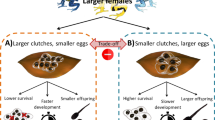Abstract
Both sexes of adultPhoracantha semipunctata F. (Coleoptera: Cerambycidae) congregate on stressedEucalyptus that are the larval hosts. In a field study, 721 adultP. semipunctata captured on host trees varied considerably in body size with the largest individuals being about twice the length of the smallest. Females that were paired with a mate were similar in size to solitary females, suggesting that the probability of a female being mated was not affected by her size. However, large males had greater success than smaller males in obtaining mates. MaleP. semipunctata rely on antennal contact to locate and identify females on the larval host. Therefore, the rate at which males search for mates is a function of the area swept by their antennae per unit time. Because of their greater antennal spread, large males were able to search for females at double the rate of the smallest males. Large males also dominated in aggressive contests for females. The superior abilities of large maleP. semipunctata in both locating and defending mates account for the influence of body size on mating success.
Similar content being viewed by others
References
Alcock, J. (1993).Animal Behavior: An Evolutionary Approach, Sinauer, Sunderland, MA.
Andersen, J., and Nilssen, A. C. (1983). Intrapopulation size variation of free-living and tree-boring Coleoptera.Can. Entomol. 115: 1453–1464.
Beeson, C. F. C., and Bhatia, B. M. (1939). On the biology of the Cerambycidae (Coleoptera).Indian For. Rec. Entomol. 5: 1–129.
Burley, N. (1983). The meaning of assortative mating.Ethol. Sociobiol. 4: 191–203.
Chemsak, J. A. (1963). Observations on the adult behavior ofXylotrechus nauticus (Mannerheim).Pan-Pacific Entomol. 39: 213–214.
Dusham, E. H. (1921). The painted hickory borer.Cornell Univ. Agr. Exp. Stat. Bull. 407.
Edwards, O. R., and Linit, M. J. (1991). Oviposition behavior ofMonochamus carolinensis (Coleoptera: Cerambycidae) infested with the pinewood nematode.Ann. Entomol. Soc. Am. 84: 319–323.
Goldsmith, S. K. (1987). The mating system and alternative reproductive behaviors ofDendrobius mandibularis (Coleoptera: Cerambycidae).Behav. Ecol. Sociobiol. 20: 11–115.
Goldsmith, S. K. (1989). Feeding ecology and the mating system forStenaspis verticalis arizonicus Casey (Coleoptera: Cerambycidae).J. Kans. Entomol. Soc. 62: 528–533.
Haack, R. A., and Slansky, F., Jr. (1987). Nutritional ecology of wood-feeding Coleoptera, Lepidoptera, and Hymenoptera. In Slansky, F., Jr., and Rodriguez, J. G. (eds.),Nutritional Ecology of Insects, Mites, Spiders, and Related Invertebrates, John Wiley, New York, pp. 449–487.
Hanks, L. M., McElfresh, J. S., Millar, J. G., and Paine, T. D. (1993).Phoracantha semipunctata (Coleoptera: Cerambycidae), a serious pest ofEucalyptus in California: Biology and laboratoryrearing procedures.Ann. Entomol. Soc. Am. 86: 86–102.
Hanks, L. M., Millar, J. G., and Paine, T. D. (1996). Mating behavior of the eucalyptus longhorned borer (Coleoptera: Cerambycidae) and the adaptive significance of long “horns.”J. Insect Behav. 9: 383–393.
Hughes, A. L., and Hughes, M. K. (1987). Asymmetric contests among sawyer beetles (Cerambycidae):Monochamus notatus andMonochamus scutellatus).Can. J. Zool. 65: 823–827.
Lawrence, W. S. (1986). Male choice and competition inTetraopes tetraophthalmus: effects of local sex ratio.Behav. Ecol. Sociobiol. 18: 289–296.
McCauley, D. E. (1982). The behavioral components of sexual selection in the milkweed beetleTetraopes tetraophthalmus.Anim. Behav. 30: 23–28.
Otte, D. (1979). Historical development of sexual selection theory. In Blum, M. S., and Blum, N. A. (eds.),Sexual Selection and Reproductive Competition in Insects. Academic Press, New York, pp. 1–18.
Paine, T. D., Millar, J. G., and Hanks, L. M. (1995). Integrated program protects trees from eucalyptus longhorned borer.Cal. Agr. 49(1): 34–37.
Ridley, M. (1983).The Explanation of Organic Diversity, Oxford University Press, Oxford.
SAS Institute (1988).SAS/STAT. User's Guide for Personal Computers. Release 6.03, SAS Institute, Cary, NC.
Scriven, G. T., Reeves, E. L., and Luck, R. F. (1986). Beetle from Australia threatens Eucalyptus.Calif. Agr. 40(4): 4–6.
Sokal, R. R., and Rohlf, F. J. (1981).Biometry, Freeman Press, New York.
Thornhill, R., and Alcock, J. (1983).The Evolution of Insect Mating Systems, Harvard University Press, Cambridge, MA.
Author information
Authors and Affiliations
Rights and permissions
About this article
Cite this article
Hanks, L.M., Millar, J.G. & Paine, T.D. Body size influences mating success of the Eucalyptus longhorned borer (Coleoptera: Cerambycidae). J Insect Behav 9, 369–382 (1996). https://doi.org/10.1007/BF02214016
Revised:
Issue Date:
DOI: https://doi.org/10.1007/BF02214016




